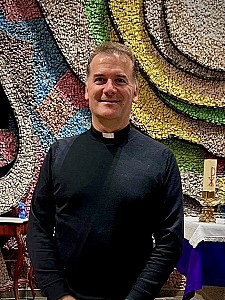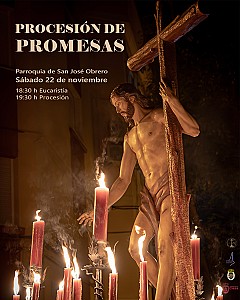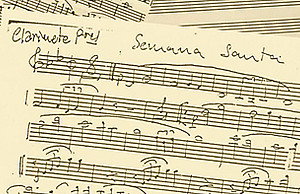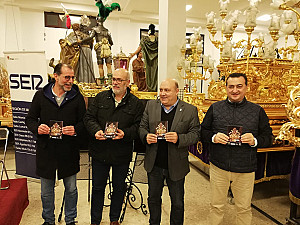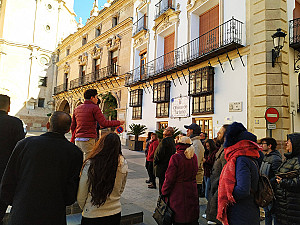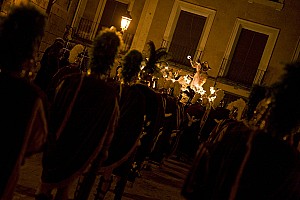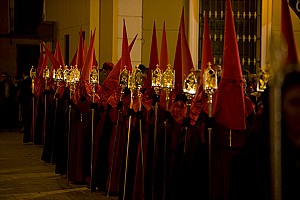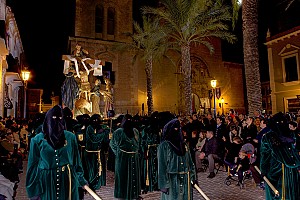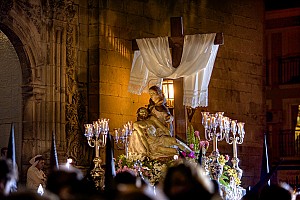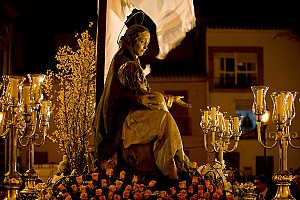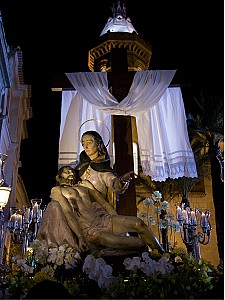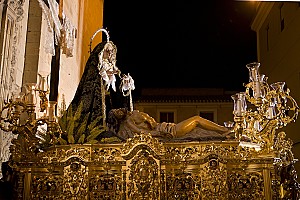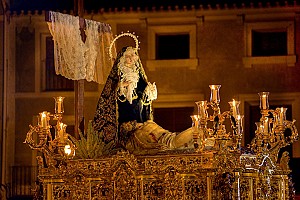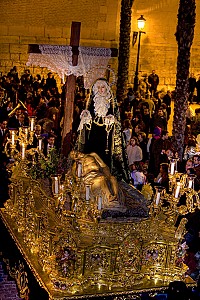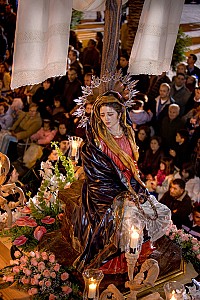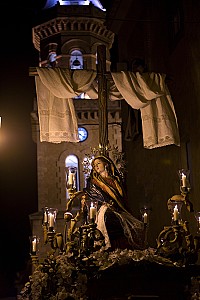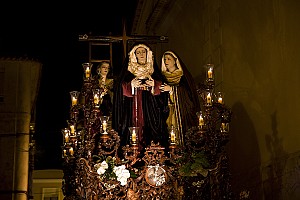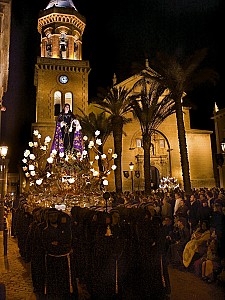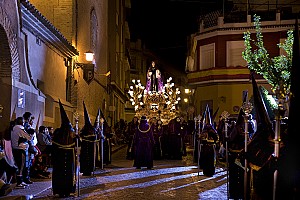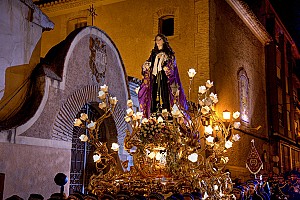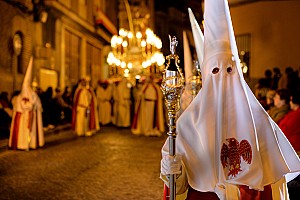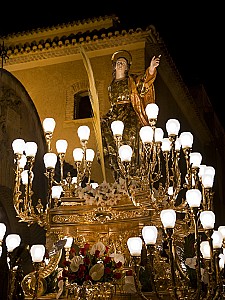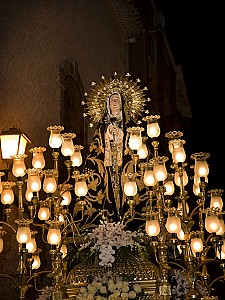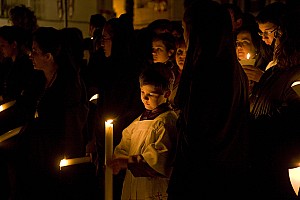Good Friday Night
DESCRIPTION
The biggest day of the Ciezano year continues in the afternoon with the
most unique prolegomena to the Burial Procession, which is the joyful transfer
of the "Holy Sepulcher" passage, the popular "Bed of
Christ", from the Calderón street garage de la Barca, accompanied by
pasodobles music: an atypical image where there are in the context of a Good
Friday, but surely not in the case of Ciezano, where it obeys a deeply rooted
custom in the Ciezano processionist, and very particularly in the Brotherhood
of the Oración del Huerto and Santo Sepulcro, the “dormis”.
And at night, the most solemn Procession of Holy Week in Cieza, which,
in addition to the Clergy, is joined by the Municipal Corporation, and other
civil and military authorities dress the night in mourning to attend the
episodic story of the Burial of Christ.
The imagery, the music, the thrones, the floral arrangement: the excellence of the ciezano heritage wears its best finery seems to shine with a different light in this Procession, which respecting in its staging the traditional internal arrangement of the Brotherhoods (Guion, Tercio infantile, Banner and Lanterns of Tercio, Tercio of Nazarenes, Tercio of anderos with the corresponding Paso and Band), focuses everything on mourning and severity, which is why the Infantile Tercios of the Brotherhood are not allowed to parade. This sense of the funerary is intensified in two very particular moments: the entrance of the Paso Santo "Santo Sepulcro" into his House-Museum, which reproduces in a very emotional way the very moment of leaving the Dead Christ in his tomb, and that of the Last I pass, the “Stma. Virgen de la Soledad", to the Plaza del Ayuntamiento, where he receives the condolences of the entire town, represented by its highest authorities.
PECULIARITIES, INTEREST OF THE SHOW AND RECOMMENDATIONS
If you have to put an adjective to this Procession, a true Museum in motion, it is without a doubt "solemn".
Solemn, to begin with, due to the quality of its impressive sculptural carvings, among which we must especially highlight the Blessed Virgin. Virgen de la Piedad (from Capuz, 1943), the Blessed. Reclining Christ (Plans, 1920), the Blessed. Virgen del Mayor Dolor (Álvarez Duarte, 2005), Our Lady of Bitterness (Romero Zafra, 2009), or María Stma. de la Soledad (González Moreno, 1942), in addition to the extraordinary carvings, already mentioned, of the Stmo. Cristo del Consuelo (17th century) and the Stmo. Christ of Forgiveness (1942); to which must be added the craftsmanship of the thrones of the Reclining Christ (Ibáñez Valles, 2008), of the Holy Women on the Way to the Sepulcher (Rubio Valverde, 2010) and of Santa María Salomé (Carrillo Marco, 1956). Each of these pieces is well worth a visit to Cieza on its own: it can be said, in short, that together they represent a true street museum of the best national religious art of the 20th and early 21st centuries. As proof of the patrimonial vitality of Holy Week in Ciez, always in search of excellence, in the year 2023 the Cofradía de la Samaritana will premiere the imposing sculptural group of the Holy Burial, made by the sculptor Antonio Jesús Yuste Navarro from Ciez, and which without No doubt it will become a masterpiece to add to the many others that appear in this procession.
Solemn is the Procession, also, due to the martiality and seclusion that the different Nazarenes and Anderos confer to their parade, and, naturally, also solemn due to the beauty and elegance of the Ciezana woman dressed in the classic Spanish mantilla or mourning veil. of the genuine “manolas” and “lloronas” that accompany, respectively, the Paso Cristo Yacente and the Paso María Stma. of loneliness.
A good place to watch the procession of the Burial of Christ without losing its episodic component would be, for example, Calle Larga, through whose narrow streets it is admirable to see the beautiful Procession Steps. This enclave, in addition to allowing us to enjoy the perfect symbiosis between the street and the procession, will give us the possibility of going, at the end of the procession, to the entrance of the "Holy Sepulchre", which is Ciez's version of the moment of leaving the The corpse of Jesus behind the stone of the Sepulchre, a recreation that includes the declamation of an emotional text by the Brotherhood itself, perfectly linked to the piece composed with superb intuition by Salmerón Morote, who hits the mark with a simple melody as passionate as it is clearly mournful. The last meeting will be, of course, at the entrance of "María Santísima de la Soledad", accompanied by the religious, civil and judicial authorities of the city, to whom condolences will be offered with the prayer proclaimed from the Torre de la Basilica of the Assumption and repeated in a murmur throughout the Plaza. Both moments, completely compatible in time, are some of the most intimate and emotional moments that we will experience this week of Ciezana passion.
ITINERARY
Plaza Mayor, Cid, La Parra, Rincón de los Pinos, Pinos, Larga, Buitragos, San Sebastián, Esquina del Convento, Mesones, Cadenas, Barco, Cánovas del Castillo and/or San Pedro and Plaza Mayor.
TIME
20:30
